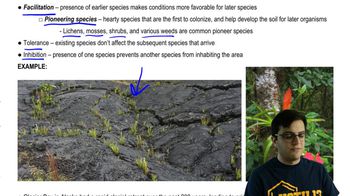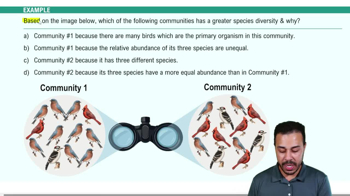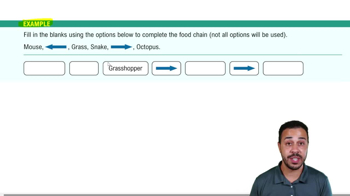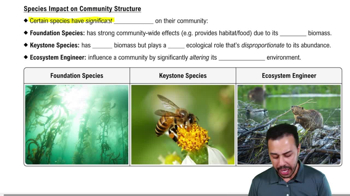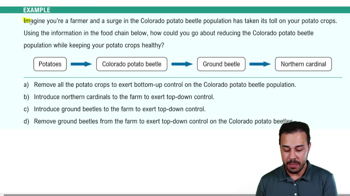Table of contents
- 1. Introduction to Biology2h 42m
- 2. Chemistry3h 40m
- 3. Water1h 26m
- 4. Biomolecules2h 23m
- 5. Cell Components2h 26m
- 6. The Membrane2h 31m
- 7. Energy and Metabolism2h 0m
- 8. Respiration2h 40m
- 9. Photosynthesis2h 49m
- 10. Cell Signaling59m
- 11. Cell Division2h 47m
- 12. Meiosis2h 0m
- 13. Mendelian Genetics4h 44m
- Introduction to Mendel's Experiments7m
- Genotype vs. Phenotype17m
- Punnett Squares13m
- Mendel's Experiments26m
- Mendel's Laws18m
- Monohybrid Crosses19m
- Test Crosses14m
- Dihybrid Crosses20m
- Punnett Square Probability26m
- Incomplete Dominance vs. Codominance20m
- Epistasis7m
- Non-Mendelian Genetics12m
- Pedigrees6m
- Autosomal Inheritance21m
- Sex-Linked Inheritance43m
- X-Inactivation9m
- 14. DNA Synthesis2h 27m
- 15. Gene Expression3h 20m
- 16. Regulation of Expression3h 31m
- Introduction to Regulation of Gene Expression13m
- Prokaryotic Gene Regulation via Operons27m
- The Lac Operon21m
- Glucose's Impact on Lac Operon25m
- The Trp Operon20m
- Review of the Lac Operon & Trp Operon11m
- Introduction to Eukaryotic Gene Regulation9m
- Eukaryotic Chromatin Modifications16m
- Eukaryotic Transcriptional Control22m
- Eukaryotic Post-Transcriptional Regulation28m
- Eukaryotic Post-Translational Regulation13m
- 17. Viruses37m
- 18. Biotechnology2h 58m
- 19. Genomics17m
- 20. Development1h 5m
- 21. Evolution3h 1m
- 22. Evolution of Populations3h 52m
- 23. Speciation1h 37m
- 24. History of Life on Earth2h 6m
- 25. Phylogeny2h 31m
- 26. Prokaryotes4h 59m
- 27. Protists1h 12m
- 28. Plants1h 22m
- 29. Fungi36m
- 30. Overview of Animals34m
- 31. Invertebrates1h 2m
- 32. Vertebrates50m
- 33. Plant Anatomy1h 3m
- 34. Vascular Plant Transport1h 2m
- 35. Soil37m
- 36. Plant Reproduction47m
- 37. Plant Sensation and Response1h 9m
- 38. Animal Form and Function1h 19m
- 39. Digestive System1h 10m
- 40. Circulatory System1h 57m
- 41. Immune System1h 12m
- 42. Osmoregulation and Excretion50m
- 43. Endocrine System1h 4m
- 44. Animal Reproduction1h 2m
- 45. Nervous System1h 55m
- 46. Sensory Systems46m
- 47. Muscle Systems23m
- 48. Ecology3h 11m
- Introduction to Ecology20m
- Biogeography14m
- Earth's Climate Patterns50m
- Introduction to Terrestrial Biomes10m
- Terrestrial Biomes: Near Equator13m
- Terrestrial Biomes: Temperate Regions10m
- Terrestrial Biomes: Northern Regions15m
- Introduction to Aquatic Biomes27m
- Freshwater Aquatic Biomes14m
- Marine Aquatic Biomes13m
- 49. Animal Behavior28m
- 50. Population Ecology3h 41m
- Introduction to Population Ecology28m
- Population Sampling Methods23m
- Life History12m
- Population Demography17m
- Factors Limiting Population Growth14m
- Introduction to Population Growth Models22m
- Linear Population Growth6m
- Exponential Population Growth29m
- Logistic Population Growth32m
- r/K Selection10m
- The Human Population22m
- 51. Community Ecology2h 46m
- Introduction to Community Ecology2m
- Introduction to Community Interactions9m
- Community Interactions: Competition (-/-)38m
- Community Interactions: Exploitation (+/-)23m
- Community Interactions: Mutualism (+/+) & Commensalism (+/0)9m
- Community Structure35m
- Community Dynamics26m
- Geographic Impact on Communities21m
- 52. Ecosystems2h 36m
- 53. Conservation Biology24m
51. Community Ecology
Community Structure
Problem 16f`
Textbook Question
Lyme disease is caused by infections of the bacterium Borrelia burgdorferi (stained blue in the inset, among red blood cells), which is transferred to humans via blood-sucking bites from the tick, Ixodes scapularis. Lyme disease can cause flu-like symptoms in the short term and more serious illnesses in the long term if not treated.
Why is Lyme disease on the rise in eastern North America?
A letter to the editor in a local newspaper asserts that 'we cannot afford to preserve natural forests, because we need to use these resources to help humans.' How could you respond to this comment in terms of Lyme disease?
 Verified step by step guidance
Verified step by step guidance1
Understand the ecological relationship: Lyme disease is caused by the bacterium Borrelia burgdorferi, which is transmitted to humans by the black-legged tick (Ixodes scapularis). These ticks rely on small mammals, such as white-footed mice, as hosts during their life cycle. Forest ecosystems play a critical role in maintaining the balance of these populations.
Explain the role of biodiversity: Natural forests support a diverse range of species, including predators of small mammals (e.g., foxes, owls). High biodiversity can help regulate populations of white-footed mice, which are key reservoirs for Borrelia burgdorferi. Reduced biodiversity, often caused by deforestation, can lead to an overabundance of these mice, increasing the risk of Lyme disease transmission.
Discuss the impact of habitat fragmentation: When forests are fragmented or destroyed, the remaining patches often favor species like white-footed mice, which thrive in disturbed environments. This can lead to higher tick populations and greater chances of human-tick interactions, thereby increasing Lyme disease cases.
Counter the argument with ecosystem services: Preserving natural forests provides numerous benefits to humans, including disease regulation. By maintaining healthy ecosystems, we can reduce the risk of zoonotic diseases like Lyme disease, which ultimately benefits public health and reduces healthcare costs.
Conclude with a balanced perspective: Emphasize that sustainable use of natural resources and forest conservation are not mutually exclusive. By protecting forests, we can support both ecological health and human well-being, reducing the spread of diseases like Lyme while still utilizing resources responsibly.
 Verified video answer for a similar problem:
Verified video answer for a similar problem:This video solution was recommended by our tutors as helpful for the problem above
Video duration:
2mPlay a video:
Was this helpful?
Key Concepts
Here are the essential concepts you must grasp in order to answer the question correctly.
Lyme Disease Transmission
Lyme disease is primarily transmitted to humans through the bite of infected ticks, particularly Ixodes scapularis. These ticks thrive in wooded and grassy areas, where they feed on the blood of mammals, including deer and rodents, which are reservoirs for the Borrelia burgdorferi bacterium. Understanding this transmission cycle is crucial for addressing the rise of Lyme disease, as it highlights the importance of tick habitats and the role of wildlife in disease spread.
Recommended video:
Guided course

Cardiovascular Disease
Impact of Habitat Loss
The preservation of natural forests plays a significant role in controlling Lyme disease. Deforestation and habitat fragmentation can lead to increased human-tick interactions, as wildlife populations may become concentrated in smaller areas, facilitating the spread of ticks. By maintaining natural habitats, we can help regulate tick populations and reduce the risk of Lyme disease transmission to humans.
Recommended video:
Guided course

Geographic Impact on Communities
Public Health and Environmental Conservation
There is a critical link between public health and environmental conservation, particularly in the context of vector-borne diseases like Lyme disease. Protecting natural ecosystems not only preserves biodiversity but also mitigates the risk of disease outbreaks. Investing in conservation efforts can ultimately lead to healthier communities by reducing the incidence of diseases that thrive in disturbed environments.
Recommended video:
Guided course

Conservation Biology and Biodiversity
Related Videos
Related Practice








